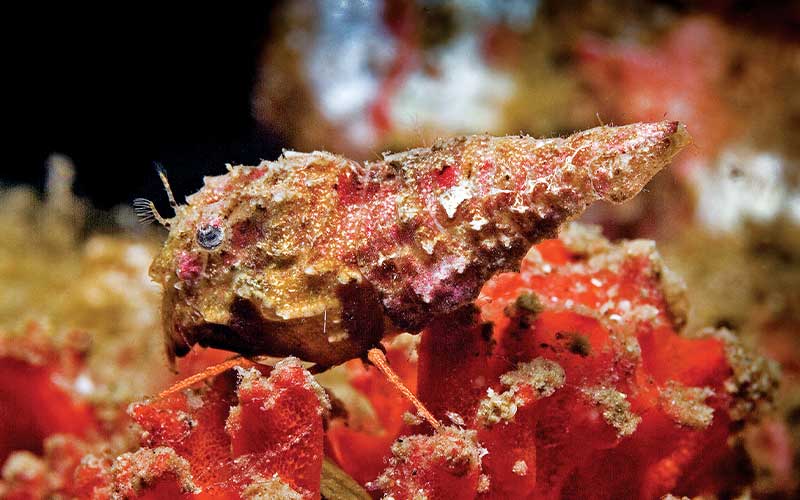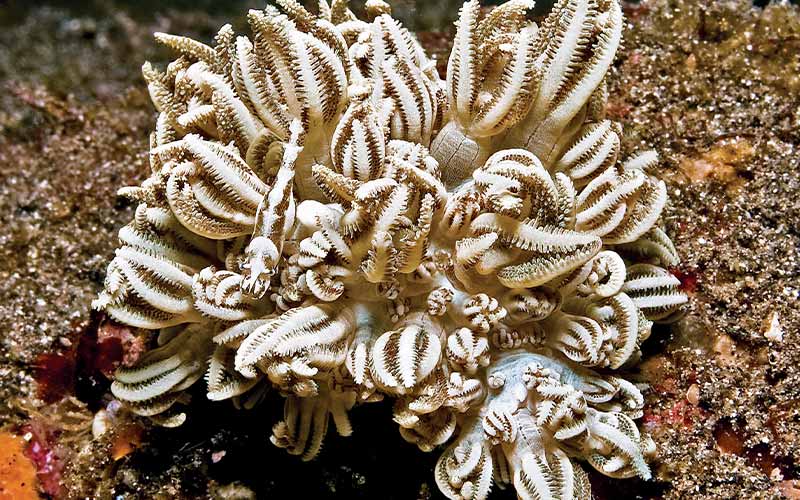I’m near the end of a night dive off the bank of Lembeh Strait, when Ben Sarinda, our Indonesian naturalist guide, begins to gesture wildly with his dive light. I know he has found something special to beckon me so close to the end of a dive, so after checking my computer and air gauge to ensure all is well, I make my way over to him.
As I reach him, my light illuminates Ben hovering just off a coral- and crinoid-encrusted overhang, his eyes locked on the ledge. I position myself at his side and set my gaze in line with his pointing finger. All I see is a common, half-inch spiraling seashell balanced on the rough contour of a red sponge. I poke Ben’s shoulder and turn my palm up in the form of a question. He turns back to the ledge and jabs his finger toward the shell with even more emphasis. Anxious about my dwindling air supply and not wanting to appear brainless, I focus my lens on the drab brown shell, snap off a few frames and head up the slope.
Back on the boat, Ben bounds up the ladder with eyes as big as biscuits. He can hardly contain his exuberance as he exclaims, “What a shrimp! Have you ever seen anything like it?” To which all I can answer is a very confused, “What shrimp?”

“On the sponge, the shrimp on the sponge. Did you get the shot?”
“You mean the shell?”
“No, the shrimp! Did you get the shot?”
Thirty minutes later we’re sitting on our bungalow’s veranda, sipping Bintang beer and waiting for the camera card to download. One at a time, postage-stamp-size images pop into view. Finally, the last four frames appear. I double-click on the first of them, and a greatly enlarged version flashes across the screen.
Just as he did underwater, Ben jabs his finger at the image. “Look,” he says, “orange legs, and there are the eyes and antennae. What did I tell you?” Sure enough, once magnified, his phantom shell turns into a most unusual shrimp. So unusual, in fact, that the extraordinary creature was scientifically described only the year before from a single specimen found in Malaysia. To quote the paper, “The shrimp appear a remarkable imitator of dead cerithiid shells.”
To avoid being eaten by the many fish who love to dine on them, invertebrates such as tiny shrimp, crabs and defenseless sea slugs have evolved sophisticated defense stratagems, many of which are quite inventive. Ben’s little shrimp increased its odds not only by emerging from its hiding place at night after most predators have bedded down, but by taking mimicry to unconventional limits, in this case evolving a spiraling carapace that resembles the unappetizing, stone-hard shell of a snail.

Months after my first encounter with the chameleon-like shrimp, the eagle eyes of Liberty Tukunang, another long-time friend and Indonesian dive guide, discover an equally improbable specimen in a field of fine rubble, mimicking a white pebble to perfection. Its camouflage is so skillful, I have to remove the shrimp from its habitat and place it on a dead piece of coral to expose its true profile.
Even more recently, only minutes after beginning a night dive on a mucky rubble slope just east of Komodo, I uncharacteristically nudge one of the numerous small white growths of pulsing, flower-like soft coral scattered over the shallow rocks. To my surprise, instead of remaining firmly in place, the colony tumbles off the rock. I carefully scoop up the loose bit in my hand and gently probe the delicate tissue, now curled into a ball. My examination reveals the unmistakable oval foot of a nudibranch. Pleased as punch to find it unharmed, I gently place the inch-long, shell-less snail back on the rock, my cupped hand shielding it from the current as it rights itself. Soon it regains its grip and begins a slow crawl.
While waiting for the animal’s remarkable gill-appendage adaptation to reshape into pulsating flowerets, I see another imitator unfold from the tangle. A soft coral commensal shrimp with white and gold trim to match the soft coral mimicked by the nudibranch emerges. Like I love to say, the sea never ceases to amaze.
© Alert Diver — Q3 Summer 2010